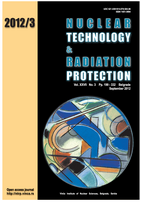
ESTIMATION OF DOSES RECEIVED BY OPERATORS IN THE 1958 RB REACTOR ACCIDENT USING THE MCNP5 COMPUTER CODE SIMULATION

Vol.
XXVII, No. 3, Pp. 199-332
September 2012
UDC 621.039+614.876:504.06
ISSN 1451-3994
Pages: 199-221
Authors: Milan P. Pešić
Abstract
A numerical simulation of the radiological consequences of the RB reactor reactivity excursion accident, which occurred on October 15, 1958, and an estimation of the total doses received by the operators were run by the MCNP5 computer code.The simulation was carried out under the same assumptions as those used in the 1960 IAEA-organized experimental simulation of the accident: total fission energy of 80 MJ released in the accident and the frozen positions of the operators. The time interval of exposure to high doses received by the operators has been estimated. Data on the RB1/1958 reactor core relevant to the accident are given. A short summary of the accident scenario has been updated. A 3-D model of the reactor room and the RB reactor tank, with all the details of the core, created. For dose determination, 3-D simplified, homogenised, sexless and faceless phantoms, placed inside the reactor room, have been developed. The code was run for a number of neutron histories which have given a dose rate uncertainty of less than 2%. For the determination of radiation spectra escaping the reactor core and radiation interaction in the tissue of the phantoms, the MCNP5 code was run (in the KCODE option) and "mode n p e", with a 55-group neutron spectra, 35-group gamma ray spectra and a 10-group electron spectra. The doses were determined by using the conversion of flux density (obtained by the F4 tally) in the phantoms to doses using factors taken from ICRP-74 and from the deposited energy of neutrons and gamma rays (obtained by the F6 tally) in the phantoms' tissue. A rough estimation of the time moment when the odour of ozone was sensed by the operators is estimated for the first time and given in Appendix A.1. Calculated total absorbed and equivalent doses are compared to the previously reported ones and an attempt to understand and explain the reasons for the obtained differences has been made. A Root Cause Analysis of the accident was done and, for the first time, a Cause and Effect diagram has been created in Cause Mapping methodology and shown in Appendix A.2.
Key words: accident, absorbed dose, equivalent dose, RB reactor, MCNP5 code
FULL PAPER IN PDF FORMAT (199 KB)